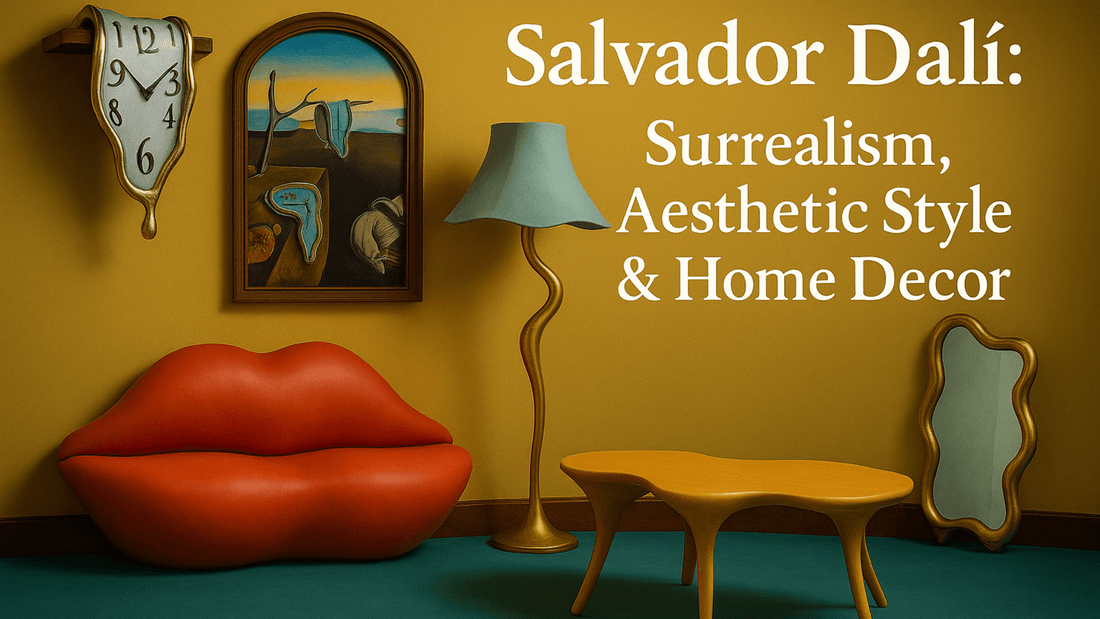
Salvador Dalí: Surrealism, Aesthetic Style & Home Decor
Share
May 12, 2025
Salvador Dalí, a name synonymous with surrealism, was far more than a painter. He was a cultural icon, a provocateur, and a master of eccentricity. Dalí's works continue to captivate audiences with their bizarre imagery, dreamlike landscapes, and psychological depth. This article explores Dalí’s surrealism, his aesthetic style, and how his artistic principles can influence home decor today.

Origins of Surrealism: A Revolutionary Movement
Surrealism emerged in the early 1920s as a literary and artistic movement inspired by the unconscious mind, dreams, and Freudian theory. Pioneered by André Breton, it aimed to disrupt the norms of rationality and realism. Dalí joined the movement in the late 1920s, bringing a unique perspective rooted in his personal experiences and vivid imagination.

Salvador Dalí's Artistic Evolution
Dalí's early works were influenced by Impressionism and Cubism, but his breakthrough came when he fully embraced surrealism. His meticulous technique, influenced by Renaissance masters, combined with fantastical subjects, distinguished his work from his contemporaries. Paintings like "The Persistence of Memory" (1931) established him as a major figure in modern art.

The Persistence of Memory: Time as a Surreal Concept
One of Dalí's most iconic paintings, "The Persistence of Memory," features melting clocks draped over barren landscapes. It visually represents the fluidity of time and challenges our conventional understanding of temporality. This piece remains a cornerstone of surrealist art and a symbol of Dalí's ingenuity.

Dalí's Symbolism: Ants, Eggs, and Elephants

Dalí employed recurring symbols to convey deeper meanings:
- Ants symbolize decay and impermanence.
- Eggs represent birth, love, and transformation.
-
Elephants with spindly legs suggest weightlessness and juxtapose strength with fragility. These motifs often appeared in various media including painting, sculpture, and film.
Techniques and Mediums: Mastering the Surreal
Dalí utilized a technique he called the "paranoiac-critical method" to access subconscious imagery. He worked across multiple mediums including oil painting, sculpture, photography, and film. This versatility made him a rare polymath of modern art.

Collaboration with Other Artists
Dalí collaborated with a variety of influential artists and thinkers including Luis Buñuel ("Un Chien Andalou"), Alfred Hitchcock ("Spellbound"), and Walt Disney ("Destino"). These partnerships expanded his surrealist vision into cinema and animation.
Fashion and Personal Style: Dalí as a Living Artwork
Dalí was also a fashion icon. His flamboyant mustache, tailored suits, and theatrical public appearances made him instantly recognizable. He often collaborated with designers like Elsa Schiaparelli, creating pieces that blurred the line between fashion and fine art.
Dalí's Influence on Contemporary Design
Dalí's aesthetic continues to influence contemporary design. His emphasis on contrast, whimsy, and surreal elements can be seen in everything from modern furniture to high fashion. Designers frequently reference Dalí to evoke mystery, elegance, and the unexpected.
Integrating Dalí’s Style into Home Decor
Bringing Dalí's vision into your home decor involves embracing surrealism and experimentation. Think beyond traditional forms and explore:
- Distorted Furniture Shapes
- Dream-Inspired Murals or Wallpapers
- Bold Color Palettes
- Unusual Combinations of Textures and Forms
Dalí-Inspired Color Schemes
Dalí often used a palette of golds, reds, blues, and blacks to create drama. Integrate these hues through accent walls, upholstery, or art pieces to echo his dynamic energy.
Surrealistic Furniture and Accessories

Some furniture designers, inspired by Dalí, have created iconic pieces like the Mae West Lips Sofa. Surrealistic furniture serves as both utility and statement art. Incorporate:
- Soft-edged Mirrors
- Sculptural Lighting
- Melting Clock Replicas
Artwork and Prints: The Heart of Dalí Decor
Reproductions of Dalí's work or Dalí-inspired art pieces can be central to a room's decor. Choose large prints, ornate frames, or shadow boxes to showcase his dreamlike artistry.
Creating a Surrealist Ambiance
Lighting, textures, and spatial arrangement are crucial. Use dim, colored lighting and layered textiles to evoke a dreamlike environment. Avoid symmetry to maintain unpredictability.
Dalí’s Legacy in Modern Interior Design
Today, designers incorporate Dalí's surrealist techniques to break visual monotony. His legacy can be seen in maximalist interiors, avant-garde spaces, and thematic hotel rooms around the world.
Conclusion: Living the Dream with Dalí
Salvador Dalí's impact transcends canvas. His surrealist philosophy invites us to explore the boundaries of imagination in everyday life. By integrating his visual language into home decor, we not only pay tribute to his genius but also transform living spaces into realms of creativity and wonder.
Frequently Asked Questions
Who was Salvador Dali and what makes his surrealism art so distinctive?
Salvador Dali (1904-1989) was a Spanish artist and one of the most influential surrealist artists of the 20th century. His distinctive painting style combined meticulous technical skill with bizarre, dreamlike imagery influenced by Sigmund Freud's theories of the unconscious.
What makes Dali's surrealism art so unique is his ability to create hyper-realistic scenes that defy logic and reality, often featuring melting objects, double images, and symbolic elements.
His most famous paintings, like "The Persistence of Memory" with its melting clocks, have become iconic in modern art history. Dali was known for his flamboyant personality and eccentric behavior, which further enhanced his enigmatic public image and cemented his status as a cultural icon beyond the art world.
How can I incorporate Salvador Dali wall art into my home decor?
Incorporating Salvador Dali wall art into your home decor can create a striking focal point that sparks conversation. For a powerful statement, choose a canvas print of a famous painting like "The Persistence of Memory" or "The Elephants" as a centerpiece for your living room.
For a more subtle approach, consider smaller reproductions or art posters of his less recognizable but equally fascinating works. Salvador Dali style pairs well with modern, minimalist interiors where the surrealist elements can stand out.
You might complement Dali's pieces with decorative elements that echo his themes—perhaps a sculptural clock reminiscent of his melting timepieces or butterfly motifs. For a gallery wall art arrangement, mix Dali prints with other surrealism art or contrasting abstract works. Remember that Dali's bold imagery makes a strong statement, so balance is key in creating harmonious room decor.
What are Salvador Dali's most famous paintings that would look great as canvas wall art?
Salvador Dali created numerous masterpieces that make stunning canvas wall art for home or office spaces. "The Persistence of Memory" (1931) with its iconic melting clocks is perhaps his most recognized work, perfect for creating a thought-provoking focal point. "The Elephants" features surreal long-legged creatures that add vertical interest to any wall. "Swans Reflecting Elephants" demonstrates Dali's mastery of double imagery and works beautifully in contemplative spaces.
"The Burning Giraffe" offers vibrant colors that can energize a room. "Metamorphosis of Narcissus" showcases his interpretation of Greek mythology with characteristic surrealist elements. "Sleep" with its suspended head supported by crutches makes for an enigmatic conversation piece.
"Soft Construction with Boiled Beans" (1937) offers a powerful political statement that appeals to collectors interested in art with historical significance. Each of these works, available as oil painting reproductions or high-quality canvas prints, brings Dali's imaginative world of dreams into your interior design.
How did Salvador Dali's childhood and education influence his surrealist art style?
Salvador Dali's childhood and education profoundly shaped his distinctive surrealist art style. Born in Figueres, Spain, Dali was deeply affected by his mother's death when he was 16 and his complex relationship with his strict father.
These early emotional experiences later manifested in his paintings through themes of decay, mortality, and sexual anxiety. His formal artistic training began at the San Fernando Academy of Fine Arts in Madrid, where he mastered traditional techniques while developing his characteristic meticulous painting style. During this period, he was exposed to and influenced by Renaissance masters as well as contemporary movements like Cubism and Dadaism. His expulsion from the academy for claiming his examiners were incompetent reflected his rebellious nature that would later define his public persona.
The culmination of these influences—his technical mastery, psychological turmoil, and exposure to avant-garde ideas—created the perfect foundation for his eventual immersion in surrealism, where he could explore the world of dreams and the unconscious through precisely rendered yet impossible scenes.
What are some affordable ways to add Salvador Dali style to my room decor?
Adding Salvador Dali style to your room decor doesn't have to break the bank. Art posters and prints of Dali's works are much more affordable than original pieces or high-end reproductions—look for sales at museum shops or online retailers specializing in art prints.
Consider decorative items inspired by Dali's iconic motifs, such as melting clock wall decor, which can be found at reasonable prices. Butterfly-themed accessories can reference Dali's use of these creatures in works like "Landscape with Butterflies." For a DIY approach, create a gallery wall art display using printed images of different Dali paintings in inexpensive frames.
Surrealism-inspired throw pillows, featuring elements reminiscent of Dali's dreamscapes, add a touch of the surrealist movement to couches and beds. Look for skull decor that echoes Dali's fascination with mortality as seen in works like "The Face of War." Even simple items like Salvador Dali coffee table books can serve as both decorative elements and conversation pieces, allowing you to bring the Spanish artist's enigmatic vision into your space without significant investment.
How can I identify authentic Salvador Dali prints and what should collectors look for?
Identifying authentic Salvador Dali prints requires careful attention to detail. Serious collectors should look for proper documentation, including certificates of authenticity from recognized Dali experts or institutions like the Salvador Dali Foundation. Authentic Dali prints typically have clear provenance that traces ownership history back to the artist or his authorized publishers.
Examine the signature carefully—Dali had a distinctive signature that evolved over time, but beware that in his later years, he reportedly signed blank sheets that were later printed with images. Look for edition numbers on limited prints (e.g., 57/250), and research which printing techniques were used for specific works. Original Dali prints might include drypoint etchings, lithographs, and woodcuts. Watermarks or embossed stamps from legitimate publishers can provide authentication.
The paper quality and age should be consistent with the purported production date. Due to the high value of Dali's work, professional appraisal is recommended before any significant purchase. Many fakes circulate in the market, particularly of his more famous paintings, so purchasing from reputable galleries, auction houses, or established dealers who specialize in surrealism art is advisable for collectors.
What themes and symbols appear frequently in Salvador Dali's surrealism wall art?
Salvador Dali's surrealism wall art features recurring themes and symbols that create his distinctive visual language. Melting clocks appear prominently, representing the fluidity and relativity of time, most famously in "The Persistence of Memory." Crutches symbolize support for weakness and appear throughout his work as structural elements. Ants frequently represent decay and mortality, while soft, melting objects reflect Dali's exploration of the malleability of reality.
The human figure often appears distorted or fragmented, referencing Dali's interest in the unconscious mind. Eggs represent fertility and rebirth in works like "Metamorphosis of Narcissus." Drawers protruding from human figures symbolize the compartmentalization of memory and the unconscious, influenced by Sigmund Freud's theories. Vast, barren landscapes reminiscent of his native Catalonia create dreamlike settings for his surrealist visions. Elephants with impossibly long, thin legs combine strength and fragility while defying physical laws.
Sexual imagery appears throughout his work, reflecting his preoccupation with desire and taboo. Religious iconography, particularly crucifixion imagery, reflects his complex relationship with Catholicism. These recurring elements create a rich symbolic vocabulary that makes Dali's canvas wall art both visually striking and psychologically intriguing.
How did Salvador Dali's relationship with Gala influence his most famous paintings?
Salvador Dali's relationship with Gala, who was first his muse and later his wife, profoundly influenced his most famous paintings and artistic development. When they met in 1929, Dali was still finding his artistic voice; after she entered his life, his work gained focus and his surrealist style fully crystallized. Gala became a frequent subject in his art—appearing as herself, as a Madonna figure, and even as Venus in multiple works.
Beyond serving as a model, she managed Dali's business affairs, allowing him to focus entirely on creating art. Her unwavering belief in his talent gave him the confidence to pursue his most ambitious and controversial artistic visions. Works like "The Madonna of Port Lligat" directly feature Gala as a religious icon, while "Galatea of the Spheres" transforms her into a masterpiece of his nuclear mysticism period. She also appears in "Dream Caused by the Flight of a Bee Around a Pomegranate a Second Before Awakening."
Gala provided emotional stability for the often erratic artist, and many art historians believe this security enabled the consistent productivity that made Dali such a prolific creator of surrealist art. Their relationship, though unconventional (Gala maintained relationships with other men), created the foundation upon which Dali built his artistic empire and public persona.
Beyond painting, what other art forms did Salvador Dali explore that can be used in home decor?
Salvador Dali's creative vision extended far beyond painting into numerous art forms that can enhance home decor. His sculptural works, like the melting clocks three-dimensional interpretations or "Space Elephant," make striking decorative accent pieces for shelves or tables. Dali designed surrealist furniture, including his famous "Mae West Lips Sofa" and lobster telephone, which inspired many contemporary decorative items available today.
He created jewelry with intricate surrealist motifs—replicas or pieces influenced by his designs add an artistic touch to display cases. Dali produced numerous prints and lithographs that are more affordable than his original paintings but still capture his unique style for wall decor. He designed textiles with surrealist patterns that inspired modern fabric designs perfect for throw pillows or upholstery. Dali also worked in ceramics, creating plates and other tableware with his distinctive imagery—reproductions of these make functional art pieces. His collaboration with photographer Philippe Halsman produced striking images that work beautifully as art prints for gallery walls.
Dali even designed stage sets and costumes for theater and ballet, which have influenced contemporary interior design elements. These diverse artistic expressions provide numerous options for incorporating the surrealist movement and Salvador Dali style into sophisticated home and room decor.
How can I create a gallery wall featuring Salvador Dali alongside other complementary artists?
Creating a gallery wall featuring Salvador Dali alongside complementary artists allows you to build a cohesive yet dynamic wall decor statement. Begin by selecting Dali pieces that resonate with you—perhaps a surrealism wall art print of "The Persistence of Memory" or a lesser-known work that captures his dreamlike aesthetic. For complementary artists, consider other surrealists like René Magritte, whose mysterious, poetic imagery pairs well with Dali's more flamboyant style.
Max Ernst's textural, fantasy-driven works create interesting dialogue with Dali's precise technique. For contrast that still maintains thematic connection, include pieces by pop art artists like Andy Warhol, whose bold colors and cultural commentary provide a different perspective on reality. Consider modernist photographers like Man Ray, whose experimental techniques echo surrealist principles.
When arranging your gallery wall, balance larger statement pieces with smaller works, and mix painting reproductions with photography or drawings for textural variety. Connect pieces through color themes—perhaps picking up the earthy tones in Dali's landscapes or the vivid elements in his more colorful works. Frame choices can either unify the collection (all black frames for cohesion) or intentionally vary (vintage frames for Dali, sleek modern frames for contemporary pieces) depending on your room decor aesthetic. This thoughtful curation creates a museum of modern art experience in your own home.


